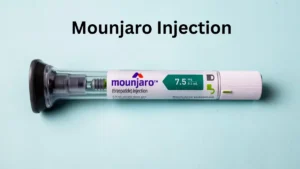Obesity and type 2 diabetes have reached epidemic proportions worldwide. According to the World Health Organization, over 890 million people were living with obesity in 2022. As a result, there’s a growing demand for effective treatments that can address both excess weight and poor glycemic control. Enter Mounjaro injection—a revolutionary medication that is transforming the landscape of diabetes management and weight loss. This article explores everything you need to know about this dual-action injectable drug.
| Aspect | Details |
|---|---|
| Generic Name | Tirzepatide |
| Brand Name | Mounjaro |
| Type | Once-weekly injectable medication |
| Approved Use | Management of Type 2 Diabetes |
| Off-label Use | Weight loss in obese or overweight individuals |
| Mechanism of Action | Dual agonist of GIP and GLP-1 receptors, improving insulin secretion and reducing appetite |
| Dosage | Starting dose: 2.5 mg once weekly; maintenance up to 15 mg once weekly |
| Administration | Subcutaneous injection in abdomen, thigh, or upper arm |
| Benefits | – Improves blood sugar control – Significant weight loss – Enhances metabolic health |
| Common Side Effects | Nausea, vomiting, diarrhea, constipation, indigestion |
| Serious Side Effects | Pancreatitis, hypoglycemia (especially with other diabetes meds), rare liver toxicity |
| Hair Loss | Not directly caused by Mounjaro; possible temporary hair loss due to rapid weight loss |
| Weight Loss Results | Up to ~22.5% body weight reduction in clinical studies |
| Who Should Use | Adults with type 2 diabetes or obesity (BMI ≥30, or BMI ≥27 with weight-related conditions) |
| Contraindications | History of medullary thyroid cancer, pancreatitis, pregnancy, breastfeeding |
| Insurance Coverage | Usually covered for diabetes treatment; coverage for weight loss varies |
| Administration Frequency | Once weekly |
| Onset of Weight Loss | Noticeable within 4–8 weeks |
| Important Note | Use under medical supervision only |
What is Mounjaro?
Mounjaro is the brand name for tirzepatide, a once-weekly injectable drug approved by the U.S. Food and Drug Administration (FDA) for managing type 2 diabetes. While its primary indication is diabetes control, Mounjaro is also prescribed off-label for weight loss, especially in people struggling with obesity or metabolic issues.
Unlike other medications in the same class—such as Ozempic or Wegovy, which only target GLP-1 receptors—Mounjaro is a dual agonist. It activates both GIP (Glucose-dependent insulinotropic polypeptide) and GLP-1 (Glucagon-like peptide-1) receptors, making it more effective at lowering blood sugar and reducing body weight.
Read more: Osteoporosis Treatment: Effective Ways to Strengthen Your Bones and Prevent Fractures
How Does Mounjaro Work?
Mounjaro mimics two key hormones involved in blood sugar control and appetite regulation:
- GIP: Enhances insulin secretion and regulates fat metabolism.
- GLP-1: Slows digestion, reduces appetite, and improves insulin sensitivity.
By activating both receptors, Mounjaro not only lowers blood glucose levels but also curbs hunger, promotes early satiety, and slows gastric emptying. This dual mechanism leads to significant weight loss over time and improved metabolic health.
Read more: Top 10 Effective Lipedema Treatments: Causes, Remedies & When to See a Doctor
Dosage and Administration
Mounjaro is administered via subcutaneous injection once a week. It can be injected into the abdomen, thigh, or upper arm.
The starting dose is 2.5 mg per week to minimize side effects. After 4 weeks, the dose is increased to 5 mg weekly as a recommended maintenance dose. Your doctor may gradually titrate your dose up to 15 mg once weekly in increments of 2.5 mg every four weeks, based on your response and tolerance. If you miss a dose, take it within 4 days; otherwise, skip it and resume your regular schedule.
Always follow your doctor’s instructions for dosage and administration.
Benefits of Mounjaro Injection
1. Improves Blood Sugar Control
Mounjaro helps type 2 diabetics by stimulating insulin production in a glucose-dependent manner, reducing the amount of glucose released by the liver, and lowering HbA1c levels (average blood sugar over 3 months).
2. Promotes Significant Weight Loss
A 2025 study presented at the European Congress on Obesity revealed that tirzepatide users lost up to 20% of their body weight over three years. Even non-diabetics reported substantial weight reduction due to appetite suppression, delayed gastric emptying, and reduced food intake.
3. Improves Metabolic and Cardiovascular Health
Mounjaro may improve blood pressure, cholesterol levels, and inflammatory markers. These changes lower the risk of heart disease and other obesity-related complications.
Side Effects and Risks
While Mounjaro is generally well-tolerated, it does come with side effects.
Common Side Effects: nausea and vomiting (especially during initial weeks), diarrhea or constipation, indigestion or bloating. These symptoms usually subside as the body adjusts to the medication.
Serious but Rare Side Effects: pancreatitis (sudden abdominal pain, nausea, and vomiting), hypoglycemia (especially if taken with insulin or sulfonylureas), and liver toxicity (rare, but reported in some high-dose cases).
Hair Loss: Mounjaro does not directly cause hair loss. However, rapid weight loss may lead to telogen effluvium, a temporary condition that results in thinning hair. Nutritional deficiencies like low iron, protein, or B12 can worsen this symptom.
Is Mounjaro Safe for Weight Loss?
Mounjaro is increasingly used off-label for weight loss in non-diabetic individuals with obesity or overweight conditions. Clinical trials have shown up to a 22.5% reduction in body weight and long-term sustainability of weight loss over 2–3 years. It’s generally safe when prescribed by a healthcare provider and combined with lifestyle changes like diet and exercise.
Mounjaro vs. Other Weight Loss Injections
Mounjaro stands out due to its dual hormone action and greater weight loss potential when compared to other drugs like Ozempic, Wegovy, and Saxenda. While Ozempic and Wegovy target only GLP-1 receptors and typically result in around 15% weight loss, Mounjaro activates both GIP and GLP-1 receptors, enabling up to 22.5% weight loss in clinical studies.
Who Should Use Mounjaro?
Ideal candidates for Mounjaro injection include adults with type 2 diabetes, individuals with a BMI of 30 or higher, or those with a BMI of 27 or higher who have weight-related health conditions. It is not recommended for people with a history of medullary thyroid cancer, pancreatitis, or for pregnant or breastfeeding women. Always consult a doctor for a personalized prescription.
Frequently Asked Questions (FAQs)
How quickly does Mounjaro show weight loss results? Most users begin seeing results within 4–8 weeks, with full effects over several months.
Can I stop using Mounjaro once I lose weight? You should only stop under medical supervision, as stopping abruptly may lead to weight regain.
Is Mounjaro covered by insurance? It is covered for diabetes management but may not be for weight loss unless prescribed for a medical condition.
Conclusion
Mounjaro injection is a powerful new option for those managing type 2 diabetes and struggling with weight. With its dual-action mechanism and once-weekly dosing, it offers effective blood sugar control and significant weight loss. However, like any medication, it comes with risks and should only be used under medical supervision. If you’re considering Mounjaro, talk to your healthcare provider to see if it’s the right fit for your health goals.





